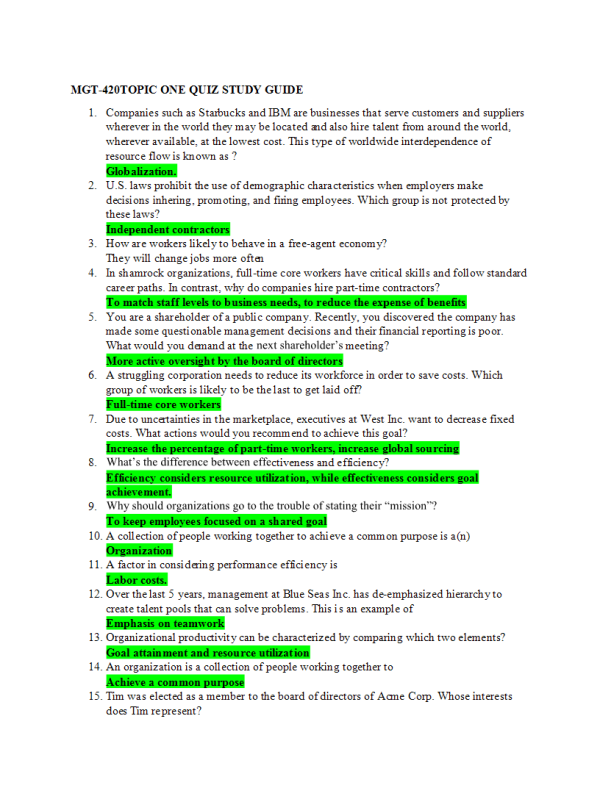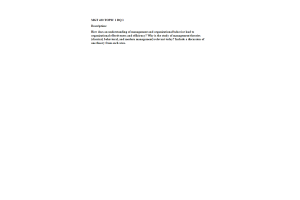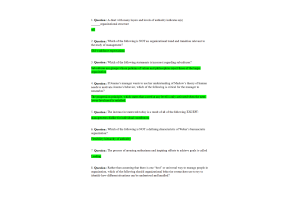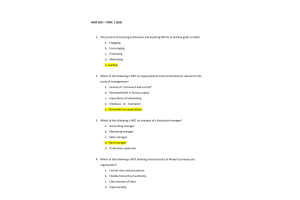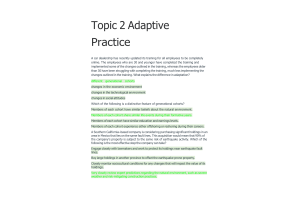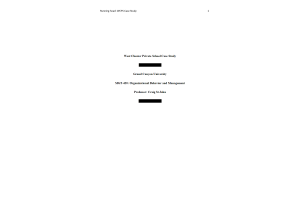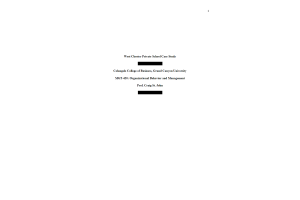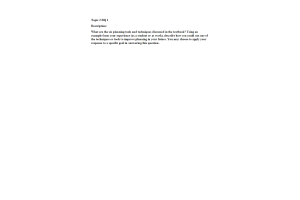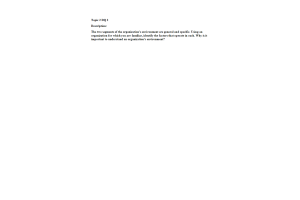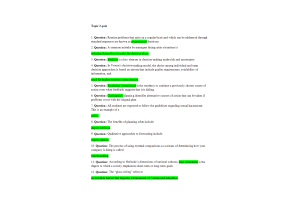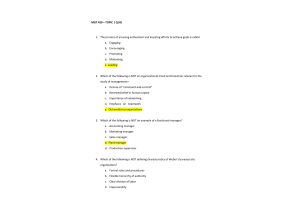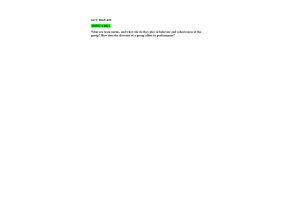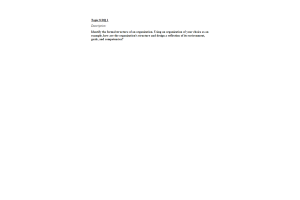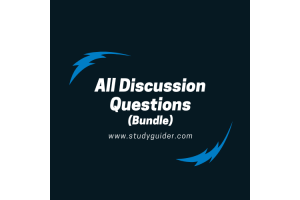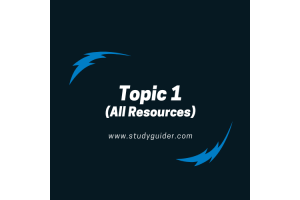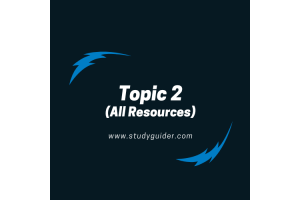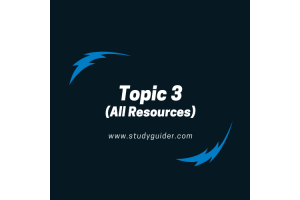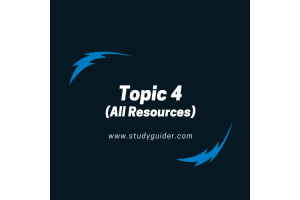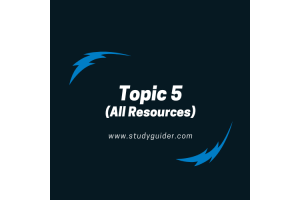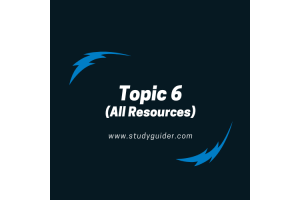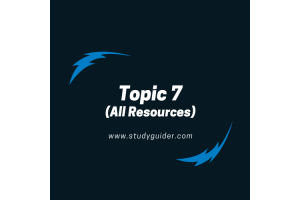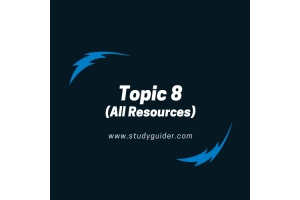MGT 420 Topic 1 Adaptive Practice
- $39.00
- Question: Companies such as Starbucks and IBM are businesses that serve customers and suppliers wherever in the world they may be located and also hire talent from around the world, wherever available, at the lowest cost. This type of worldwide interdependence of resource flow is known as ?
- Question: U.S. laws prohibit the use of demographic characteristics when employers make decisions inhering, promoting, and firing employees. Which group is not protected by these laws?
- Question: How are workers likely to behave in a free-agent economy?
- Question: In shamrock organizations, full-time core workers have critical skills and follow standard career paths. In contrast, why do companies hire part-time contractors?
- Question: You are a shareholder of a public company. Recently, you discovered the company has made some questionable management decisions and their financial reporting is poor. What would you demand at the next shareholder’s meeting?
- Question: A struggling corporation needs to reduce its workforce in order to save costs. Which group of workers is likely to be the last to get laid off?
- Question: Due to uncertainties in the marketplace, executives at West Inc. want to decrease fixed costs. What actions would you recommend to achieve this goal?
- Question: What’s the difference between effectiveness and efficiency?
- Question: Why should organizations go to the trouble of stating their “mission”?
- Question: A collection of people working together to achieve a common purpose is a(n)
- Question: A factor in considering performance efficiency is
- Question: Over the last 5 years, management at Blue Seas Inc. has de-emphasized hierarchy to create talent pools that can solve problems. This is an example of
- Question: Organizational productivity can be characterized by comparing which two elements?
- Question: An organization is a collection of people working together to
- Question: Tim was elected as a member to the board of directors of Acme Corp. Whose interests does Tim represent?
- Question: Why is Prasad responsible for the performance of his work team members?
- Question: In order to manage the dynamics of dependency and accountability, a manager should
- Question: In most companies, which position is furthest away from non-managerial workers in the organizational structure?
- Question: Joanna is the president of a typical non-profit organization. Who is responsible for overseeing Joanna’s position?
- Question: Which of the following terms refers to a person who is responsible for the work of others?
- Question: The upside-down pyramid view of organizations places which people at the top?
- Question: Informational roles focus on the giving, receiving and ______ of information.
- Question: In what way are agenda setting and networking similar?
- Question: Janelle recently completed a project she was assigned to manage. As she reviewed her performance, she noted that she was successful in leading her team and with setting and measuring performance objectives. Despite this, the project still had problems because Janelle neglected the critical function of
- Question: Martha, a technology company CEO, is in the midst of a corporate-wide reorganization when owing to family issues she suddenly retires. The board of directors knows that she was a master of arranging tasks, creating ways of achieving difficult goals, and ensuring results. To finish the reorganization Martha started, the board is looking for
- Question: During this year’s annual performance evaluation, Ernie’s boss said that she admired the way Ernie planned, organized and controlled his team and projects. However, she would like Ernie to focus more on improving his team leadership.
- Question: Which of the following best defines the planning process?
- Question: As a part of Will’s job at a foundation, he is expected to build portfolio of social capital. Which strategy would best serve Will in this goal?
- Question: Arin recently learned of the four management functions in a management seminar she took. Should she expect to perform these functions in the same order over the course of each workday?
- Question: Setting performance objectives, arranging tasks, inspiring people, and ensuring desired results area part of
- Question: Successful manager enact three types of roles. When it comes to decisional roles, what is the primary goal?
- Question: Brenda is an accountant. Cindy is and Engineer. Doug is a financial planner. What do Brenda, Cindy, and Dough most likely have in common?
- Question: To be successful as a CEO, which two qualities are most necessary?
- Question: The process of ____ consists of measuring performance and taking action to ensure desired results.
- Question: Which abilities are examples of technical skills?
- Question: Tammy is the type of person who is naturally inspiring. She is able to encourage people to work hard, and she often helps others achieve results.
- Question: In his decisional role as a manager, Scott’s primary goal should be to _____.
- Question: Logic, order, and legitimate authority are the underpinnings of
- Question: Which of the following would best exemplify fun’s bureaucratic ideal of careers based on merit?
- Question: Scientific management is a classic management system that rests on which of the following assumptions?
- Question: In practice, which management approach often sacrifices efficiency for fairness?
- Question: Which of the following is critical legacy that emerged from Taylor’s scientific management approach?
- Question: The owners of a small restaurant chain currently hire trained and skilled short-order cooks to prepare foods. Eventually, they want to be to hire unskilled workers to prepare the food. What would you recommend as the most effective approach?
- Question: Which of the following steps would you take first in order to perform a motion study for a package delivery service?
- Question: Apple’s Genius Bars provide individualized service and quality customer experience.
- Question: Company executives regularly go on retreats to develop long-term strategic plans. This is an example of which managerial duty?
- Question: A manager who endorses McGregor’s theories is most likely to believe
- Question: Which of the following is an example of a lower- order need?
- Question: According to the deficit principal, what is likely to happen once a lower- order need is satisfied?
- Question: Truong has been called in as a consultant for a company that is having problems retaining talented personnel. A concerned manager tells Truong, “This company need to embrace Theory Y”. What does the manager want Truong to accomplish?
- Question: How would you distinguish between higher- order needs and lower- order needs?
Higher-order needs are primarily psychological, whereas lower-order needs are primarily
- Question: Which of the following is likely to characterize a work environment whose managers endorse the perspective of Chris Argyris?
- Question: Jake has confided in his mentor that he has a growing need for respect, prestige, recognition, and personal sense of competence. What need is Jake describing?
- Question: The tendency of a person singled out for special attention to perform as expected is known as
- Question: Which statement best characterizes the relationship between the classical management and human resource approaches to management?
- Question: You have been hired as a consultant to explore productivity problems within organization. Your analysis reveals communication and process inefficiencies occurring between operations, marketing, and finance. Why is this company struggling?
- Question: You are a manager at a large corporation that has just implemented a new pay-for-performance system. Although performance has increased, you suspect that employee morale has decreased, and you are concerned that productivity will decrease over time. What action do you recommend?
- Question: The primary belief of contingency thinking is that management practices should
- Question: A manager who wants to avoid management fads would most likely engage in what type of management?
- Question: The basic scientific method can be used to do what?
- Question: You have been hired as a consultant to explore productivity problems within a large organization. Your analysis reveals that the company tends to address every problem in the same way. Which management strategy could improve productivity for this company?
- Question: Which type of thinking tries to match management practices with situational demands?
- Question: Avery is interested in how data can be used to understand and solve problems in management. Avery is interested in which approach of management?
- Question: If Jessica is interested in making dresses, where will she go to seek resources?
- Question: How is a collaboration economy different from one that is not collaborative?
In a collaborative economy, employees and managers work together to finish work, serve customers, and share ideas information. In a non-collaboration economy, work does not get done, customers’ needs are not met, and a breakdown in communication prevents
- Question: According to organizational behavior, which of the following illustrates the worst kind of organization?
- Question: Modern organizations tend to employ people from various generations. Newer generations desire balance work and non-work responsibilities more so than previous generations. Which other characteristic of new generations is frequently observed?
They are less tolerant of hierarchal structures, they want the latest technology, and they
- Question: A goal of organizational behavior is to improve the quality of work overall.
- Question: One trend in organizational behavior is focusing om leadership from all employees, not only fromthe bosses
- Question: When Company A relies on all team members to show strong technology skills, a great example
- Question: How can an organization improve both sales and employee culture?
- Question: Which of the following is a trend in an organizational behavior?
- Question: In the ever-changing job market, which of the following jobs would best serve a person who has an understanding of organizational behavior?
- Question: Which of the following items is most important for contingency thinking?
- Question: Contingency thinking requires a thorough study of
- Question: Evidence- based management means
- Question: Which BEST describes the science of organizational behavior?
- Question: Making decisions based on “hard facts” instead of “dangerous Half-truths” describes a style known as
- Question: Jaquez is a unit supervisor of F.S. Inc., a commercial coffee service provider. He does not like Metilda, the department head of logistics, who, because she is small and frail looking, he assumes is incompetent. When she arrives late one day, Jaquez reports her to J.W. who is president of F.S. Inc., and explains that her lateness is proof she not doing her job well. However, Matilida had already received approval by J.W. to take a half day for personal reasons. Jaquez’s behavior is MOST likely an example of
- Question: An experienced manager is facing a problem in the organization that is similar to one encountered in different organization, Although the problem is similar, the manager is reluctant to immediately apply the successful solution used in the previously encountered problem without thoroughly investigating the problem and thinking about other alternatives. This manager is engaging in
- Question: Dr. Vieria considered himself a superior critical thinker in the field of geographical economics. However, he always questioned his experts and colleagues along with challenging respected theories of his profession. He disagreed with most opinions concerning the changes in terrain and the effects on the global economy. He continued to publish his controversial concepts in the distinguished magazine,
Geo Explorer. Dr. Vieira’s conduct is MOST likely a model of intellectual independence
- Question: Which of the following is an example of evidence- based management?
- Question: What is similarity between a flat organizational structure and decentralized decision making?
- Question: Judah is a project manager with a work situation that allows fluidity. He also works with Fareed who is the main supervisor. They must be careful not to have complications between them. They are both in charge and should make sure employees are not confused by having two leaders. Their structure formulation could be considered as a(n)
- Question: Which of the following BEST describes the relationship between span of control and organizational context?
- Question: How do we know what an organization’s structure is?
- Question: Which of the following correctly defines organizational context?
It is the characteristics of a job, organization or work situation that affect the way people
- Question: Structure influences how people
- Question: Yael works in phone sales at a company attempting to become a top contender in the software market. At the end of each day, the company awards a bonus to the employee completing the most calls. At the end of each month, all sales employees meet for lunch and celebrate the person who had the highest sales numbers. Yael expends her energy making as many calls as she can each day, even to clients she knows will not make a purchase. Yael is likely motivated by which aspect of organizational context?
- Question: You like rules and formal standards. What type of organizational structure is likely your BEST fit?
- Question: A direct line authority for conducting the major business of the organization is known as
- Question: Espoused values are the explicitly
- Question: Margret is the owner and operator of a photography studio and employs 10 other photographers and graphic artists. Margret started her company 8 years ago and hired employees slowly and methodically, making sure that the people working for her and with her were right fit for what she was growing.
- Question: Strong culture is characterized by consistency of beliefs and
- Question: Rituals are Systems of standardized and reoccurring activities used to influence
- Question: What differentiates espoused values from enacted values?
- Question: How do we know what an organization’s culture is?
- Question: Adam is the president of intellect now, a respected think tank. He regularly holds business meetings with his staff and clients. He is conscientious that his policies and philosophies are carried throughout the organization. Which of the following BEST applies to Adam and his role with the think tank?
- Question: All employees who work on the floor in customer-facing roles at the cosmetic company MAC wear all black clothing, although not all clothing is the same. For example, one employee may wear black denim pants and a black turtleneck whereas another employee may opt to wear black trousers and a short-sleeved black cashmere sweater. MAC employees all over the globe adhere to this dress code. What cultural sign does this relate to?
- Question: How do we build more effective cultures?
